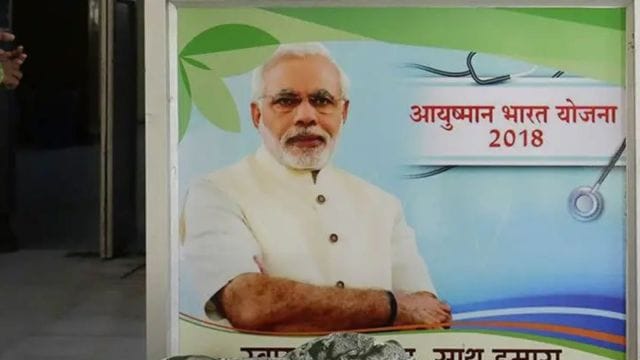Beneficiaries aged 70 years and above made up over 12 per cent of all admissions under the government’s flagship Ayushman Bharat health insurance scheme, with their treatment costs accounting for nearly 14 per cent of the total expenditure till January, according to data presented in Parliament by the Union Ministry of Health and Family Welfare.
The data shows that of the nearly 6.2 crore approved hospital admissions till January 2024, as many as 57.5 lakh were senior citizens aged 70 years and more. The government’s expenditure for treatments under the scheme reached a staggering Rs 79,200 crore over the last six years till January 2024, of which Rs 9,878.5 crore was allocated to treat those who are 70 years and over.

The costs and number of admissions frame the challenge for the BJP-led government with one of the party’s key poll agenda being an ambitious expansion of Ayushman Bharat to include all individuals over 70, irrespective of their economic status. This move is set to add nearly 4 crore new beneficiaries to the programme. At present, only the poor, who figure in the SECC data, are among those with access to the annual Rs 5 lakh coverage under the scheme.
HOW THE COST OF THE COVER GOES UP
Experts estimate the cost of expanding the coverage to all persons over 70 years would be higher than that for covering the poorest 40 per cent across all age groups. “The cost to the exchequer is likely to increase when older people of means are also covered. First, health-seeking behaviour — accessing hospitals for care — is more in older people who are relatively affluent, meaning the number of people who utilise the policy is likely to be much higher. Second, the premiums too are likely to be higher for older individuals as they are more likely to need healthcare for chronic conditions and their complications,” said Dr Indranil Mukhopadhyay, health economist and professor at the School of Government and Public Policy at O P Jindal University.
While the Ayushman Bharat insurance scheme was extended for the ASHA and Anganwadi workers during the government’s interim budget in February, no mention of any further expansion was made while the full Budget was presented in July. The allocation for the insurance scheme was also flat; it increased by only Rs 100 crore to Rs 7,300 crore.
With an ageing population with inadequate health coverage, the expansion of the scheme for those over 70 years across all income groups is expected to have a significant impact. India’s population over the age of 60 years is estimated to increase from 8.6 per cent in 2011 to 19.5 per cent by 2050, according to the Longitudinal Ageing Study in India (LASI). In terms of absolute numbers it means that the population over the age of 60 years is set to triple from 103 million in 2011 to 319 million in 2050.
BIG SPENDER
The proportion of hospital admissions for older individuals exceeded 10 per cent — their projected share in the country’s total population — in several states. Maharashtra led with 20.49 per cent, followed by Kerala (18.75 per cent), Haryana (18.13 per cent), Bihar (16.56 per cent), Himachal Pradesh (16.37 per cent), Uttarakhand (15.23 per cent), Telangana (11.53 per cent), Uttar Pradesh (10.99 per cent), Karnataka (10.92 per cent), Jharkhand (10.35 per cent), and Punjab (10.14 per cent).
Story continues below this ad
In stark contrast, Tamil Nadu recorded the lowest proportion of hospital admissions under the scheme, with older individuals comprising only 3.12 per cent of total admissions. Notably, Tamil Nadu is known for its proactive health-seeking behaviour. Despite the lower admission rates, the state’s spending on the care of older individuals was 7.45 per cent of its total healthcare expenditure under the scheme. This indicates that the cost of treatment for the relatively few older individuals in Tamil Nadu is significantly higher than for the general population.
Among the larger states, the highest proportion of spending on elderly care was seen in Maharashtra (27.49 per cent), Kerala (19.9 per cent), Haryana (19.8 per cent), Himachal Pradesh (16.98 per cent), Bihar (16.8 per cent), Uttarakhand (16.56 per cent), Karnataka (15.04 per cent), and Punjab (14.67 per cent).
In Maharashtra, not only hospitalisations for older individuals was significantly high compared to their population share, the spend too was substantially higher. Dr Akash Jaiswal, consultant of geriatrics at the Fortis Memorial Research Institute, said: “Treatments for even common conditions like pneumonia are much higher for the elderly. This is because they are likely to take longer to heal, they are more likely to get secondary infections, their other parameters such as blood sugar, electrolytes, and blood pressure take longer to balance, and they are more likely to need ICU care which is costlier. They are also much more likely to have multiple comorbidities that may lead to more complications.”
Only four states/ UT — Goa, Ladakh, Lakshadweep, and Jharkhand— showed a higher proportion of hospital admissions for older individuals compared to the total money spent on them. These are mostly very small.

































